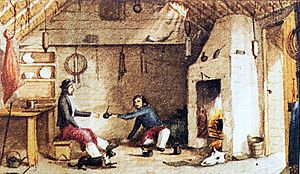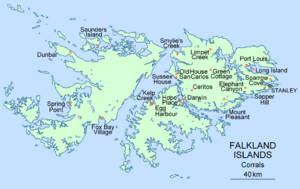Hope Place facts for kids

Hope Place (also known as Valle Esperanza in Spanish) was once a small community located in an area called Lafonia on East Falkland. It was started in 1846 by Samuel Lafone, a businessman from Montevideo, Uruguay, who was born in Britain. The settlement was built on the southern shores of Brenton Loch.
Most of the people living there were gauchos, who are skilled horsemen and cattle herders, brought over from Uruguay in South America. Today, Hope Place is no longer active and the area is abandoned.
Contents
The Beginning of Hope Place
Hope Place was founded in 1846 by a man named Samuel Lafone. He was a very successful merchant, which means he bought and sold goods, and he lived in Montevideo, Uruguay. Lafone had a big plan to develop the southern part of East Falkland, an area known as Lafonia.
He wanted to create a large ranching operation to raise cattle and sheep. To do this, he needed a place for his workers and their families to live. That's how Hope Place came to be.
Who Lived at Hope Place?
The main workers at Hope Place were gauchos. These were tough, skilled horsemen from Uruguay, famous for their work with livestock on the vast plains of South America. They were brought to the Falkland Islands to help manage the herds of cattle and sheep.
They lived and worked at Hope Place, helping to build the ranching industry that Samuel Lafone dreamed of. The watercolour painting by Dale, who was the manager of Hope Place in the 1850s, shows some of these gauchos enjoying a traditional drink called mate.
Life at the Settlement
Life at Hope Place would have been challenging but also full of activity. The gauchos spent their days herding animals, building fences, and working on the land. They brought their unique culture and traditions from South America to the Falkland Islands.
The settlement was located near Brenton Loch, which provided access to water and was a good spot for a community. Although it was a small place, it played a part in the early history of ranching on the Falkland Islands.
Why Hope Place is Abandoned Today
Over time, the way ranching was done on the Falkland Islands changed. Larger, more modern farms developed, and the need for small, isolated settlements like Hope Place decreased. Eventually, the community was no longer needed, and people moved away.
Today, if you visit the area where Hope Place once stood, you won't find a bustling settlement. It's now an abandoned site, a quiet reminder of an earlier time in the Falkland Islands' history when gauchos helped shape the landscape and economy.
See also
 In Spanish: Valle Esperanza para niños
In Spanish: Valle Esperanza para niños
- Lafonia
- History of the Falkland Islands
- Origins of Falkland Islanders


